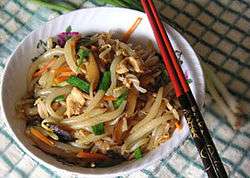Silver needle noodles
Silver needle noodle (simplified Chinese: 银针粉; traditional Chinese: 銀針粉; pinyin: yín zhēn fěn) or Rat noodle (Chinese: 老鼠粉; pinyin: lǎo shǔ fěn) is a variety of Chinese noodles.[1] It is short, about 5 cm long and 5 mm in diameter. It has a white semi-transparent colour. The noodle is available in many Chinese markets in Chinese populated areas such as Hong Kong, Taiwan, Indonesia, Malaysia and Singapore.
Names
Quite a number of names have been used to describe the noodle. The noodle is more commonly known as silver needle noodle in Hong Kong and Taiwan, and rat noodle in Malaysia and Singapore. It is known as locupan in Indonesia. The noodles are named as such because the shape of the noodles is long and tapered much like a rat's tail, translucent white like needles, or from the way the noodles are made by pushing them through the holes of a sieve.
- Yin Zhen Fen, Ngan Jam Fan (銀針粉/银针粉)
- Lao Shu Fen, Lou Syu Fan, Lo Cu Pan, Loh See Fun (老鼠粉)
- Bee Tai Bak, Mi Tai Mu (米苔目/米台目)
- Mi Shai Mu (米篩目/米筛目)
- Short Rice Noodle
Production
The noodles are made from a mixture of ground rice flour from glutinous or non-glutinous rice and water, but sometimes combined with cornstarch to reduce breakage during cooking.[1] The noodles are made by pushing the rice and water mixture through a sieve directly into boiling water in the same manner as Spätzle.[2] The noodles are made before hand and then further prepared before serving. The noodles are only available fresh and they are made by noodle vendors or commercially produced and seldom homemade as it is too tedious to make a small amount for home consumption.
Preparation

Fried Lao Shu Fen / Fried Yin Zhen Fen / Fried Short Rice Noodles
The noodles may be stir-fried, scalded and flavored with a mixture of sauces, cooked in soup or cooked dry in a clay-pot. As with most Chinese noodles, it can be served for breakfast, lunch or dinner as a main course or supplementing a rice meal. Many Chinese restaurants, hawkers and roadside stalls serve the noodle in various forms. One of the famous dishes that can be found widely in Southeast Asia is Clay-Pot Lao Shu Fen.[3] The purpose of using clay-pot is to keep warmth of the dish.
See also
External links
References
|
|---|
|
| Variants | |
|---|
|
| Dishes | Chinese | |
|---|
| Japanese | |
|---|
| Korean | |
|---|
| | |
|---|
| Thai | |
|---|
| | |
|---|
| Indonesian | |
|---|
| Malaysia/
Singapore | |
|---|
| Others | |
|---|
|
|---|
|
Instant noodle
brands | |
|---|
|
| List articles | |
|---|
|
| See also | |
|---|

